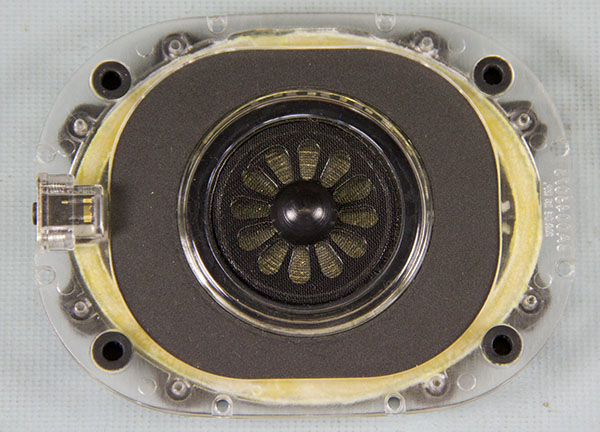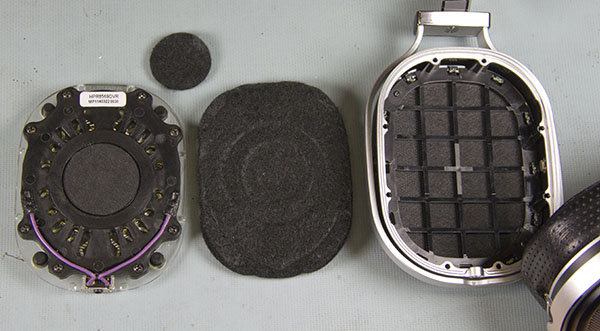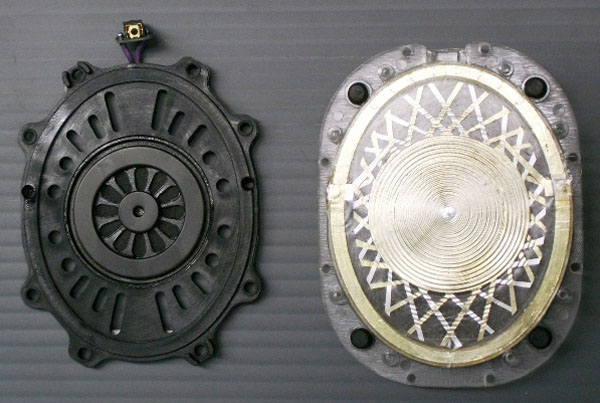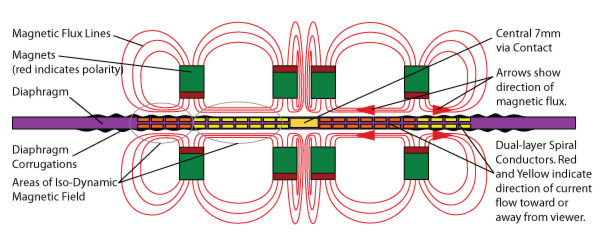| Columns Retired Columns & Blogs |
The Scrumptious Oppo Digital PM-1 Planar Magnetic Headphone Page 2

PM-1 Planar Magnetic Driver Description
Having had the opportunity to have numerous email exchanges with Igor Levitsky, I'll be including some of his thoughts as I work through the description and justifications for this driver design.
One of the first things the observant headphone enthusiast will notice about the PM-1 is that, while it is a planar design, the sound radiating from the diaphragm surface does not go directly to the ear, but rather has to travel through a "mandarin" segmented hole prior to getting to the ear. This has raised quite a few eyebrows among headphone enthusiasts (including myself) who in general believe that one of the advantages of planar headphones is a flatter acoustic wavefront hitting the ear more naturally resulting in better imaging.
Levitski brings some other interesting points into play. Having a large diaphragm output through a smaller hole effectively increases the particle velocity of the air, increasing air compression at the opening. Another point is that because it's so close to the ear, high frequency sound radiating from the outer surface of large planar drivers will take take longer to arrive at the ear potentially causing interference problems. I'll provide a lightly edited quote, and then my thoughts about it:
In PM-1 the compression effect is mostly working at LF to create more energy and punch at LF and lower mid frequencies since the whole radiated energy from large oval diaphragm is combined and then pushed through the central opening. This creates an additional acoustic load for the diaphragm which is also good but requires a more stable diaphragm.At higher frequencies diaphragm's periphery is not as effective and gradually is cut off so only the center portion is active. This allows for more focused radiation. In general, this is where all the theory of thin film transducers falls apart considering the complexity of diaphragm and its vibration and adding the ear load variations and effects. Even ear simulators do not really guarantee results above 8 kHz. The whole headphone design becomes more of a mixture of experience, art and other skills and endless listening.
The smaller radiation area of PM-1 at HF is what creates a characteristic response and also, in my opinion, very focused sound—more so than from other large planar-magnetic driver. Due to the fact that sound comes from multiple locations relatively to the ear canal it may have some coherency issues related to that multiple arrivals.
The "mandarin" openings were also optimized for better performance. Its secondary or may be tertiary role is to act in some way like a phasing plug counteracting and dispersing some very HF modes from the diaphragm and smoothing few peaks. As you see the rear plate has also opening that are oriented radially more or less for the same purpose acoustically unloading the diaphragm.
Okay...wow. Obviously a lot of though has gone into these drivers and I think we enthusiasts need to look at this with an open-mind as well as our traditional skepticism.
One thing that strikes me is driving a hole with a larger diaphragm that has the ability to narrow it's response as frequency rises presents an interesting opportunity for acoustic tuning that doesn't rely on static resonant lumped-elements. Seems quite plausible to me.
Ortho-heads out there will also no doubt want a look at the damping in the PM-1...and there's plenty of it. First, a picture.

To the left you see the rear of the driver itself. Under the pad in the center is a piece of glued-in felt covering the rear mandarin opening. The felt circle above and to the left also goes over this hole. Next is a fairly thick (maybe 7mm) felt pad that covers the entire rear of the capsule. (I keep saying felt, but it's really a specialized matt of acoustic damping material.) Lastly, there is a piece of thinish felt clamped between an internal latice and the outer metal grill.
In the picture of the front of the driver at the top of the page, you can see a large gray matt surrounding the mandarin opening. This appears to be an acoustic damping foam.
Lastly, visible in the front page photo, the ear pad has a solid plastic backing with only an opening for the driver mandarin hole. Around this hole in the rear of the earpad is a felt washer who's inside diameter is about the same size as the mandarin hole.
Igor provides some interesting input regarding the PM-1 damping.
PM-1 has very nice dampening felt behind the driver. There is no reflection from the structure whatsoever back through the diaphragm, yet there is decent attenuation of upper mid and HF. Also the arrangement of rear holes and front opening in the driver adds acoustic load impedance and makes the driver less sensitive to external obstructions. When you bring your hands close to the ear cups you don't notice much difference and this is the whole idea. The combination of the above allows people to listen to PM-1 outside. May be not on a subway but for sure in a bus or train or even a plane (with some noise limitations of course). Besides you can lean on a chair, lay on a pillow, have your hands over the headphones—not a problem. The sound would not be affected as much as with other totally open cans.
While the PM-1 does provide some modest isolation, it remains an open headphone, and I don't agree that it would make for good listening on a plane or train. I will attest to the fact that you can listen with your head on a pillow without altering the sound too much, and I have used the PM-1 walking around in my relatively quiet neighborhood with good success. Certainly these cans are better suited to portable use than the larger and heavier planar magnetic headphones out there.
Interestingly, I've already begun to see reports of people playing around with the PM-1 damping. I'm not suggesting that it's necessary, but rather making the observation that the headphones are well built, relatively easy to disassemble, and are responsive to modification.
For me, the most interesting part of these headphones is the driver itself. Unlike Audeze, HiFiMAN, and Abyss planar magnetic drivers which use a serpentine circuit pattern and linear bar magnets, the PM-1 uses ring magnets and spiral circuit pattern on the diaphragm. I'm going to be looking at exactly how this driver works and its magnetic circuit in a moment; if you're not familiar with how planar magnetic headphones work I suggest you read this article first for the basic information.

The photo above shows the rear half of the driver assembly to the left, and the diaphragm assembly to the right. In the part on the left, you can see two ring magnets one inside the other flanking the mandarin hole. Let's start with Igor's description:
The diaphragm in PM-1 is a large oval and its driven area is a large circle that almost goes to the edges of the oval across its minor axis while leaving some un-driven areas at the periphery along the oval's major axis. It has two layers of conductors on both sides arranged in quite elaborate pattern and is progressively corrugated to provide stability, structural dampening, and to allow for lower resonance considering the degree of diaphragm tensioning. I would say in this way, the diaphragm is tensioned at certain degree and the combination of the tensioning, corrugation, and diaphragm parameters was optimized for best performance.The diaphragm is also positioned in between circular magnetic half-systems and has certain acoustic loading, with rather low acoustic compression mechanism that is formed by larger vibrating surface radiating to the front into a smaller opening. The back of the driver has openings over the larger area. The diaphragm does have a distinct fundamental resonance that is controlled by various means.
The combination of mass, compliance, and acoustic radiating load is what creates that fundamental resonance that you see around 250-300Hz. (Ed: This can be seen as bumps in the impedance plot in the measurements on the next page.) In fact, the progressive corrugation provides a decoupling mechanism whereas the diaphragm's coherently vibrating area at some point narrows to smaller size as the frequency goes up. This is done on purpose. That is why in some cases you may see two small peaks. First around 200-220Hz of the whole oval diaphragm and then a bit higher in frequency the resonance of the circular portion with active conductors.
The circular magnets in PM-1 drivers are magnetized vertically along the axis. The two central discs are facing each other with South poles and two rings are facing each other with their North poles. So each par of magnets is repelling from each other. Therefore the magnetic field is squeezed in between the magnets and is directed from the gap between the discs to the gap between the rings. There is also a magnetic fringe field area at the outside edges of the larger magnetic rings that is also used in PM-1 by strategically placing conductors in that remote area and helping to distribute driving force more evenly.
Again, quite obviously a lot of thought in this driver. In order to give you a better picture of what's going on here, I've drawn up my best guess of what the magnetic and electrical circuit of the PM-1 driver looks like. Igor has checked the diagram and feels it accurate enough for the purposes of this article.

The above diagram is a cross section of the driver. The two sets of ring magnets (one set in front and one behind the diaphragm) apear as eight green rectangles, but remember these are cross sections of the ring magnet. So, for example, the two green rectangles center-top are actually one ring magnet seen in cross section.
The ring magnets on either side of the diaphragm oppose each other (north to north, and south to south on the outer and inner rings respectively), and the magnetic field between the rings is squeezed to form a ring of iso-dynamic magnetic field. Current in the circuit traces all rotate in the same direction in this area. I've shown current flow in the diaphragm traces with red and yellow colors; remembering that this is really a spiral, when the current is coming at you it's shown in yellow, and in red when going away from you.
Notice that when you go outside the large ring magnet, the magnetic flux changes direction. In order to take advantage of the magnetic field here and create a larger driving surface, the rotational direction of current in the spiral circuit traces are reversed, causing motor force to be aligned with that of the circuit traces between the ring magnets. The small central potion of the diaphragm inside the small ring magnet is not used for motive force; there is a 7m via here connecting the two layers of traces.
In the photo of the diaphragm further up the page you can see the diaphragm corrugations used as part of the suspension, resonance, and damping control of the driver. The linear metal traces criss-crossing the outer part of the diaphragm control, in part, the stiffness of the diaphragm.
The last area to discuss prior to getting to my aural impressions is the ear pads. Both the leather and velour earpads are designed to leak moderately. The downside of this configuration is that it's difficult to achieve low bass response—which is one of the reasons for the need to increase bass compression in the driver. On the other hand, the type of seal I get when I do measurements is not often achieved on real life what with hair, skull shape differences, and glasses getting in the way of a perfect seal. Here's Igor's thoughts:
I designed PM-1 to be low acoustic impedance headphones. The frontal cavity between the diaphragm and ear drum is vented. Not only it allows cooling and prevents vacuum effect (like with some other cans) it also makes headphone less sensitive to acoustic load, which means air leakage variations due to different head shapes, fit issues due to anatomical parameters of listeners pinna or eye glasses, and also due to internal anatomical deviations of concha and ear canal will have less effect.It is well known fact from many researches that anatomic deviations are huge. Around 1990 we did a research work. We took about 12 people in our acoustic and nearby amplifier department and put 1 mm B&K probe microphone in their ear canal at ERP point and measure actual headphone frequency response. Well... we were shocked to see that deviations in some cases were up to 15 db around 3-5 kHz. Sure people adapt to their individual anatomical parameters, but in any case having headphone with low acoustic impedance allows more consistent performance. I would expect enthusiasts to have more consistent opinion about PM-1 sound than with other large planar magnetic headphones where the front cavity is totally sealed and with non-corrugated relaxed diaphragm one would expect very significant deviation not only at LF but in that critical 3-5kHz region as well.
This vacuum effect has big benefit in measurements. Large diaphragm + totally sealed ear pad on the measurement rig results in flat bass down to 10Hz. In fact, with old analogue B&K rig from later 80s in Ukraine's lab Konstantin measured LF down to 5Hz and it is still flat! It is all about compression effect in the chamber where the constant excursion shows constant SPL. Enthusiasts need to remain aware of the fact that in real life this is never the case. People have glasses, they have hair, and they have imperfect skin and ears. There is always leakage. Other planar magnetics with a sealed front chamber that measure perfectly will show very different result if measure on real head. The HD 800 in this regard are probably most stable headphones that practically have the same sound regardless of the ear or head shape or fit. Very smart design. PM-1 is something in between with vented ear pads. It will show some slight roll off below 30Hz, but people should understand that this is what they would experience in reality on real ears.
PM-1 has two types of ear pads. They sound different even though some people say that they should sound the same in mid and bass since FR are close. I think that those who want a bit more HF resolution may use velour since it has lower peak at 2-3 kHz but a bit more energy at 4-6 kHz.
Okie dokie. A very interesting driver and acoustic configuration indeed, but the proof is in the pudding: How do they sound?
Sound Quality
This one is going to be a little bit troublesome for me. I'm a sucker for "juicy" sounding headphones, and the PM-1s are yummy. Personally, I love the way they sound—liquidly smooth, beautifully balanced, plenty of slam, and a nice helping of articulation with nary a trace of harshness. However, they are a bit rolled off at the extremes and mildly mid-heavy—sort of an old school sound—and don't have the resolution and finesse of the best $1000-$2000 flagship headphones.
While mid-bass and below seems very slightly loose, low in level, and rolled-off, it also manages to deliver a terrific sense of dynamic focus and punch in the mid-bass to low-mid area. Mids are rich, full-bodied, and wonderfully liquid—rather like a luscious tube amp sound. Measurements show, and Igor confirms, that the mid-range is where most of the distortion exists in these cans, and that it has a strong 2nd order harmonic relative to other distortion products. That's not to say the distortion is high in the mids (about 1%THD=noise @ 100dBspl, which is low enough not to be problematic), just that they're sonorous and pleasant when evident. All I can say is that the lush mids coupled with the dynamic punch lower down really did it for me.
The transition from mids to treble is marvelously smooth, but the level begins to roll off a bit at first, then more severely in the mid-treble. Despite its somewhat recessed nature however, the treble response is remarkably articulate and well behaved. The PM-1 has zero harshness without being dull sounding. I did hear a bit of haziness, around cymbals for example, that seemed to take away from that last bit of refinement that can be had in some reference headphones. My perception in the end though was that the level was fine (for me, which means most people would want it a couple dB higher), but the image wasn't very deep.
It seems to me that there's a tendency for headphones (and speakers) to either have body and punch, or have big imaging, but will rarely possess both. And so it is with the PM-1 to my ears: The body of the sound is glorious, but the image is narrow and close. When I compare the latest LCD-2 with the PM-1 I find the tonality similar, but I find the imaging deeper and wider on the LCD-2, while the PM-1 has more body and punch.
I spent some time comparing the PM-1 in the exalted company of the Sennheiser HD 800 and Audeze LCD-3 and LCD-2 driven by the Apex Audio Teton ($5000) and AURALiC Taurus Mk2 ($1899), and the Stax SR-009 driven by the KGSS SRE. It was evident to me that the PM-1 did respond well to better front end gear, but never quite made it to what I would consider reference level. Similarly, the LDC-2 ($999) with it's slightly grainy presentation also seem to lack that last bit of refinement needed to claim a top spot. Personally, I preferred the PM-1 over the LCD-2 in this setting. I will note however, that I found the PM-1 too syrupy sounding on the Teton—its low impedance and already juicy nature make the PM-1 a headphone for low output impedance amps, methinks.
Bottom line: This headphone is going to be a bit divisive. Lots of people like that exciting "U" shaped fun EQ curve, and the PM-1 is quite the opposite. But if you're like me and enjoy a laid-back, polite headphone that's full-bodied and punchy, this may just be your cup of tea.
PM-1 in Context
In my mind, the Oppo PM-1 is less a reference headphone and more a luxury portable headphone. Not portable in terms of using it on an airplane or train, but portable in terms of being able to use it poolside or in a motel room while traveling, for example—things I wouldn't likely do with an LCD-2 or HD 800. I've been using the PM-1 a lot with the Astel&Kern AK240 and it's a brilliant combination. Not only is the sound glorious, but I can easily move from the dining room to back porch in perfect convenience and comfort. An LCD-2 would feel cumbersome in comparison, and the better efficiency of the PM-1 makes it a bit easier to drive from a variety of potable sources.
'Luxury portable' implies a healthy investment in pride of ownership details and the Oppo PM-1 delivers on all fronts from packaging to headphone construction materials. I absolutely see a place for the PM-1 amongst the more affluent enthusiasts. For those looking simply to get the greatest sonic bang for the buck, the shortly to be released PM-2 is likely the way to go. The PM-1 has luxury build quality, absolutely top-notch, and you pay for it. You get what you pay for though, this is one of the nicest headphone product presentations I've seen. Very, very, nice.
Summary
The Oppo Digital PM-1 is a gorgeous luxury general purpose headphone ideal for the well-heeled audiophile looking for a polite, juicy, laid-back sound. Though their imaging falls a bit short, their punchy dynamism without trace of harshness, for me, is a worthy trade-off. The PM-1 has excellent efficiency and is easily driven by portable players, and it does respond well to ever better upstream gear, but in the end falls just short of reference level due to it's overly-polite sound and slightly smeared mid- and upper-treble response. Those with interest in the headphone, but without the well stocked wallet may want to consider the upcoming PM-2 expected to ship without the fancy presentation box and with a reduction in headphone materials quality (artificial leather vs. lambskin etc).
 I struggle quite a bit figuring out whether or not the PM-1 deserved a slot on the "Wall of Fame". While it's sound qualities are right up my alley, I know they're not going to satisfy a large swath of enthusiasts who prefer a brighter treble response, and I acknowledge they fall short of reference quality. On sonic performance alone they would not quite warrant a slot on the wall. On the other hand, for me, they were preferable to the LCD-2 with it's slightly grainy sound, and are far more comfortable and convenient for general purpose use. So after much consideration, I'll be knocking the LCD-2 off the WoF, and replacing it with the PM-1 for its slightly better sound, to my ears, and significantly superior ergonomics and styling.
I struggle quite a bit figuring out whether or not the PM-1 deserved a slot on the "Wall of Fame". While it's sound qualities are right up my alley, I know they're not going to satisfy a large swath of enthusiasts who prefer a brighter treble response, and I acknowledge they fall short of reference quality. On sonic performance alone they would not quite warrant a slot on the wall. On the other hand, for me, they were preferable to the LCD-2 with it's slightly grainy sound, and are far more comfortable and convenient for general purpose use. So after much consideration, I'll be knocking the LCD-2 off the WoF, and replacing it with the PM-1 for its slightly better sound, to my ears, and significantly superior ergonomics and styling.
Video
Resources
Oppo Digital home page and PM-1 product page.
Head-Fi threads here and here.
- Log in or register to post comments




































